
by AmyPlano | Jun 23, 2019 | PCOS and carbohydrates, PCOS and Weight Gain
Did you know there are over 50 DIFFERENT names for added sugar ? Now, that is KRAZY with a capital K!
And let’s be crystal clear – I am NOT talking about the type that naturally occurs in fruits, veggies, whole-grain products as well as in dairy. We are talking about the sugar that is added to food during processing to enhance flavor, texture and shelf life.
Added sugar is typically composed of the either glucose, fructose and/or sucrose. Unfortunately, many food manufacturers are sneaky and hide the total amount by listing it under several different names on a package’s ingredient list.
As if reading labels wasn’t hard enough to begin with!
Any look familiar?
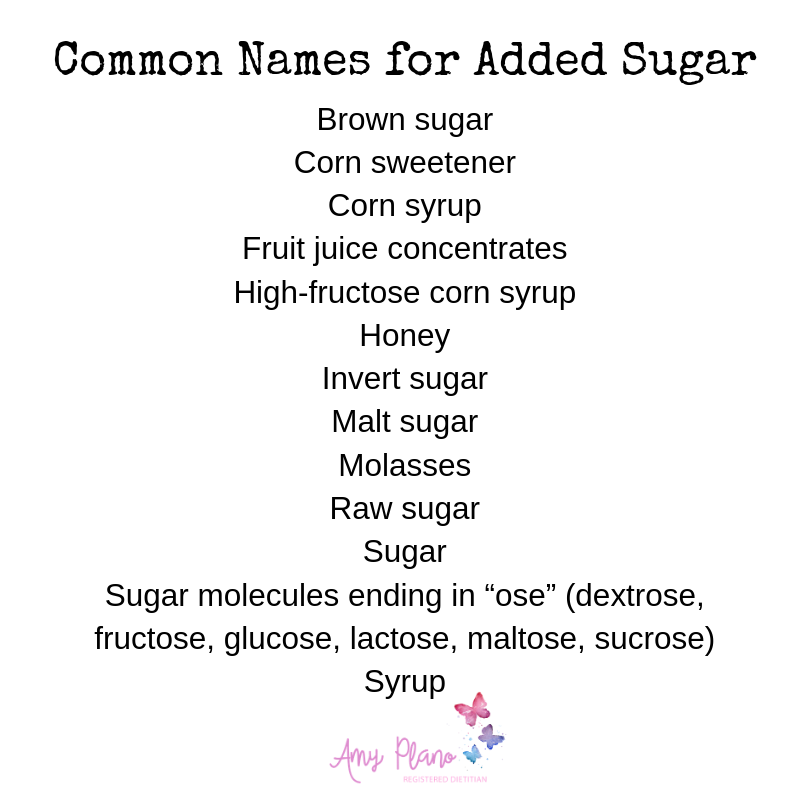
However, sadly the list does not end here my friends. Check out this quick article from Healthline to learn about the 56 (yes, you read that correctly!) other names that sugar goes by.
Talk about an unsavory alias!
Do any of these surprise you?
Raise your hand if you thought agave was a better choice than white sugar?
Surprised to hear that coconut sugar is a “no-go”?
That leads us to the next important question.
How much added sugar are you allowed per day?
Survey says…
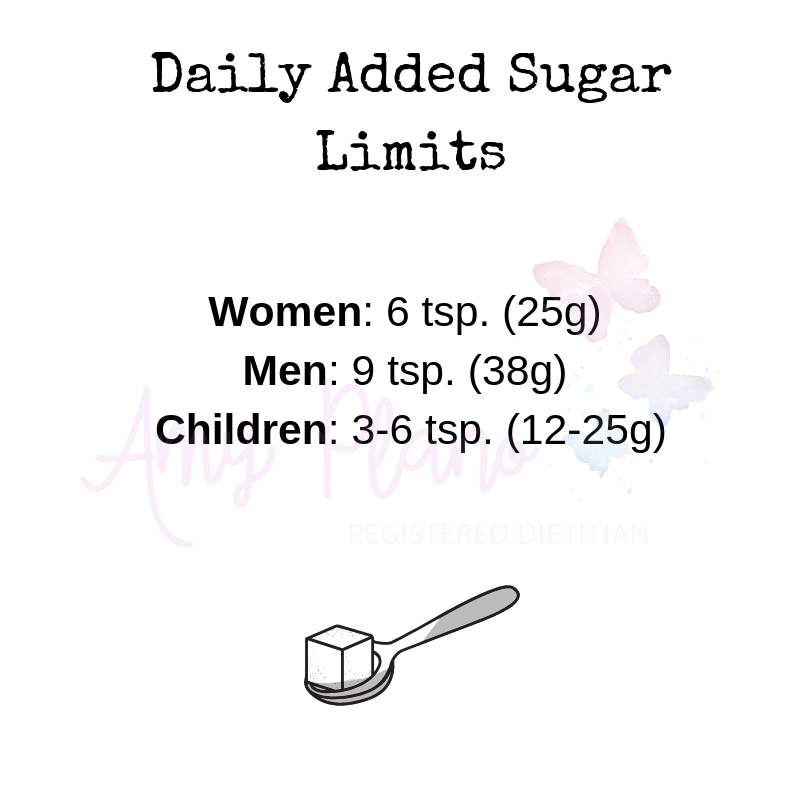
But let’s not sweat the small things. Whole foods like fruits, veggies, whole-grains and dairy products naturally contain small amounts of sugar. However, they are also nutrient powerhouses brimming with fiber, vitamins, minerals and phytonutrients. With these added features, whole foods are processed differently and don’t have the same detrimental effects of added sugars.
Therefore, the most effective way to reduce your added sugar intake is to J.E.R.F. – just eat real food. Plain and simple.
However, if you do decide to buy packaged foods, don’t be a slave to label. Be an informed consumer and stick to your daily quota.
Got questions on added sugars? Hit us up in the comments below. We understand this topic can in fact be tricky and we are happy to help!
Hugs & High Fives,

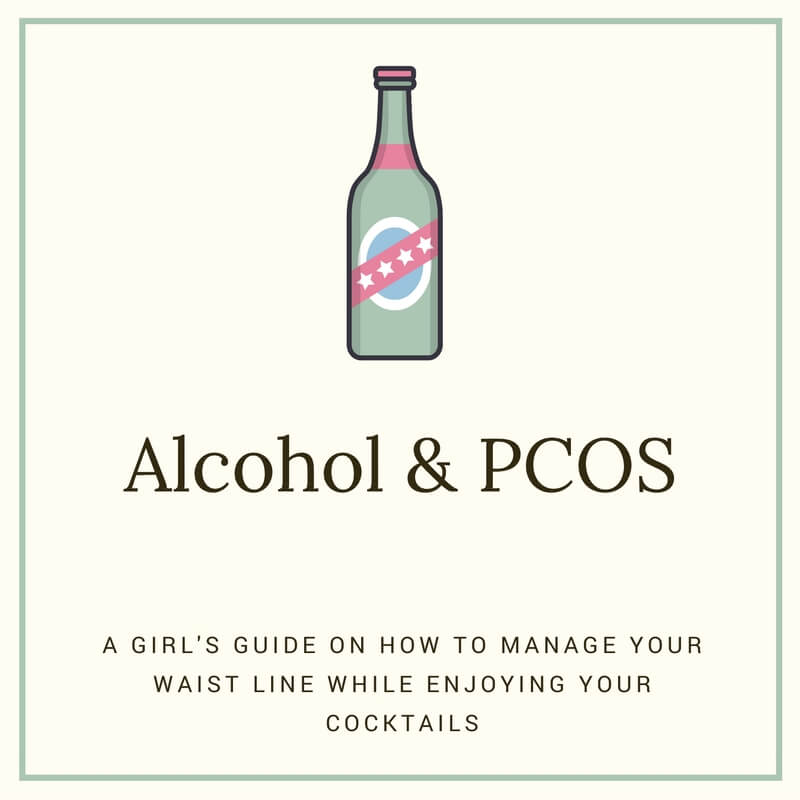
by AmyPlano | Sep 27, 2016 | PCOS and alcohol, PCOS and College
Alcohol and PCOS
It’s Saturday night and your friends ask you to go out for a cocktail. But, you can’t stop thinking…how the heck does alcohol and work with my PCOS? What drinks should I stay away from? Are there things I CAN drink that might be better for my PCOS? Or do I just need to sit there like a lump-on-a-log having no fun at all? Fret not cysta’, I have all your answers and then some in my latest blog post on alcohol and PCOS.
While I am certainly not encouraging you to party those cute little pants off, I want you to understand that having PCOS does not mean you have to give up the occasional drink. Here are a few simple tips for drinking alcohol without completely derailing your PCOS weight loss plan.
Eat before
Don’t drink on an empty stomach! Alcohol is absorbed much more rapidly when your stomach is empty. This means you will feel the effects of alcohol faster. Do yourself a favor and eat something with a modest amount of fat and protein before heading out to the bars. The protein and fat are digested slowly and act as a buffer for the alcohol.
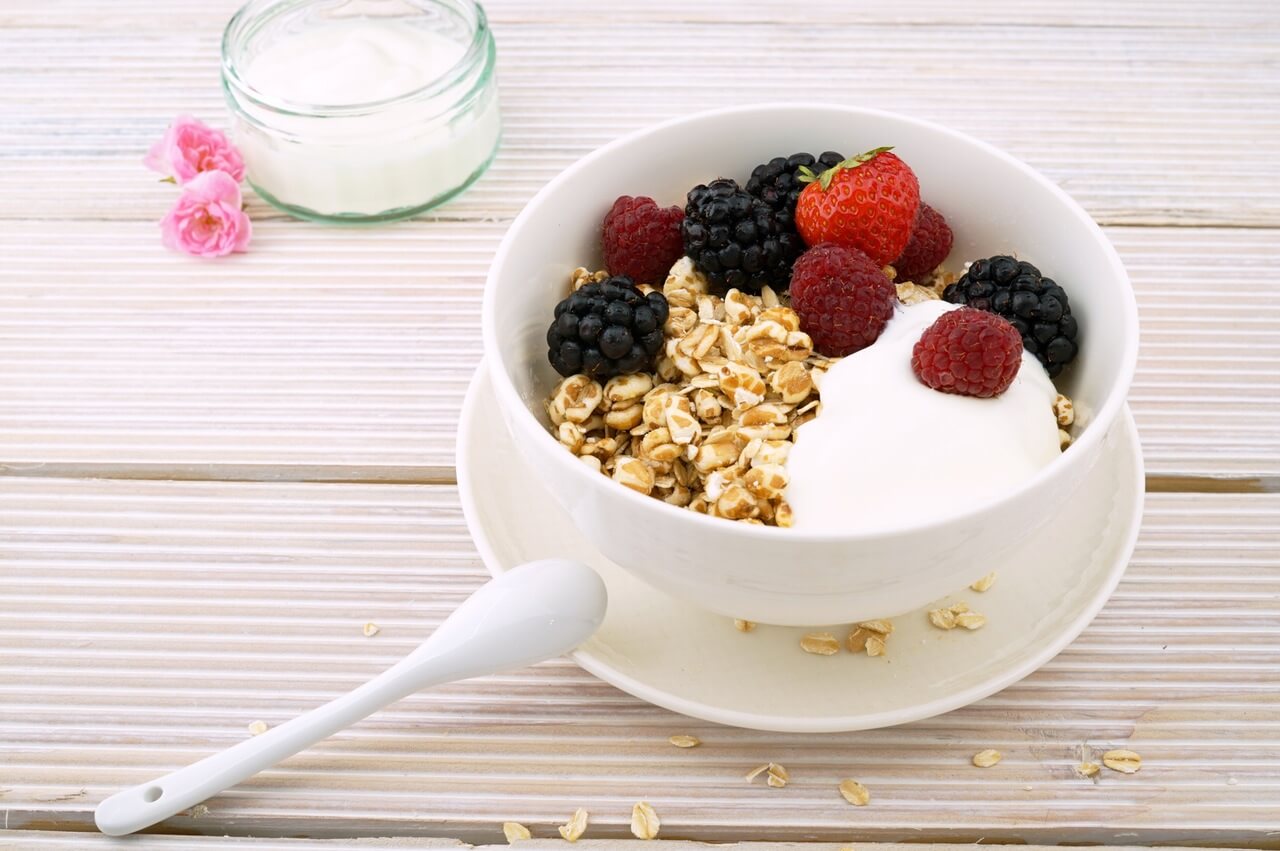
Combine a container of 2 % Greek Plain yogurt with 1/2 cup of berries and a sprinkling of granola and you have yourself an awesome “pre-game” snack!
Good choices include a container of 2 % Greek yogurt with 1/2 cup of fruit and a tablespoon of granola. a serving of whole-wheat crackers and low-fat cheese or some yummy guacamole and raw veggies.
Squash temptations
Also by consuming a meal or snack before heading out, you may be more likely to stay away from the greasy, carby bar food that may be calling your name. We all know alcohol lowers our inhibitions. Almost as soon as alcohol enters the blood stream it can hijack lower one’s personal inhibitions. Yeah, it will make a person feel more relaxed and outgoing — but it also drops our inhibitions and prompts us eat many things we would not ordinarily eat if we were sober. Did somebody say nachos? pizza? Chinese food? How we LOVE you so after a couple of cocktails! ♥♥♥ But, if we are full and satisfied by our meal, we will not even want those tempting foods.
Be mindful of your meds
If you have PCOS there is a good chance you are on Metformin. Metformin and alcohol don’t mix well at all. This is especially the case if you often drink a lot of alcohol or you binge drink (drink a lot in short periods). These effects include an extremely low blood sugar level, called hypoglycemia, and a condition called lactic acidosis.
While lactic acidosis is rare, it can be serious. It’s caused by a buildup of lactic acid in your blood. When you take metformin, your body produces more lactic acid than it usually does. When you drink alcohol, your body can’t get rid of lactic acid as quickly. Drinking too much alcohol, especially with metformin, can cause a buildup of lactic acid. This buildup can cause serious damage to your kidneys, lungs, heart, and blood vessels.

Be very mindful of the harmful effects of combining metformin & alcohol
Symptoms of lactic acidosis include:
♦ weakness
♦ tiredness
♦ dizziness
♦ light-headedness
♦ unusual muscle pain, such as sudden and severe pain in muscles that don’t usually cramp
♦ trouble breathing
♦ stomach discomfort, such as a fluttering feeling, nausea, cramping, or sharp pains
♦ feeling cold
Therefore, if you anticipate a big night of drinking hold off on taking your metformin for at least 48 hours. Lactic acidosis is a serious emergency and not something to mess around with. If you take metformin and have been drinking and you notice these symptoms, call your doctor right away or go to the nearest hospital’s emergency room.
Set a limit and stick to it
Alcoholic beverages contain a significant amount of calories with minimal nutritional value. Having one or two drinks won’t ruin your weight loss attempts but consuming any more on a regular basis can. Therefore, prior to going out, come up with a ‘game plan.’

Make sure to establish a drink limit before you even set foot out of the house. Stick to your guns and you will ‘thank yourself’ the next morning
Decide on how many drinks you are going to have AND what they will be. Share your plan with one of your friends who will be out with and have them hold you accountable.
Make better choices
Stay away from the specialty cocktails or blended drinks. While these look delicious, most are very high in calories and sugar. Some specialty drinks contain over 500 calories and 50 + grams of carbohydrates PER DRINK. Whoa Mama!
Instead make better choices. Choose a light beer, glass of wine, or hard alcohol (gin/vodka/rum/tequila) on the rocks, with diet soda, or soda water and lime to save on calories and carbohydrates. All hard alcohol has no carbohydrates. It is the mixers (juices, syrups, regular soda) that contain all the carbohydrates. If you need more flavor than using the soda water and lime, ask for just a splash of juice and you will still significantly save on calories and carbohydrates.

Frozen drinks pack a serious carb punch – coming in at around 65 grams of carbohydrates – pina coladas are one of the worst choices when it comes to alcohol and women with PCOS.
Just because it is a clear liquid – don’t let the tonic water fool you. Tonic water has the same amount of calories and carbohydrates as regular soda. Boo! You’re better off sticking to soda water or diet soda.
So now that you know what you cannot drink – let’s get down to business with what you CAN drink!
PCOS Friendly Cocktails
I bet you did not even think there was such a thing! Well, girl friend the PCOS dietitian would not leave you hanging, right?
Low-Carb Mojito
The traditional mojito uses simple syrup for sweetening, but if you use a diet lemon-lime soda like Diet Sierra Mist or Diet Sprite, you can get all of the sweetness without all the carbs.
Make it! Mix one shot (1.5 ounces) of rum with fresh lime juice and diet lemon lime soda. Pour over to muddled mint leaves with crushed ice.
Estimated calories: 110
Estimated carbohydrates: 1.5 grams
Carb-Free Gin & Tonic
Oh I know we are already into Fall – but cannot we savor our summertime favorite — the gin and tonics just a little while longer? They’re crisp and cool, but like I mentioned above tonic water is loaded with carbs, with 21 grams per cup! Swap out regular club soda or flavored seltzer for your tonic, and you’ll get the flavor without hurting your waist line.
Make it! Mix one shot (1.5 ounces) of gin with club soda water or seltzer water, a squeeze of lemon or lime. Serve over ice.
Estimated calories: 150
Estimated carbohydrates: <1 gram
Diet Jack & Coke
Obviously, a regular cola would destroy your skimpy daily carbohydrate allowance. But diet soda lends itself to many carb-free cocktails. This spin on the traditional Jack & Coke simply uses Diet Coke instead.
Make it! Mix one shot (1.5 ounces) of whiskey with Diet Coke. Serve over ice.
Estimated calories: 100
Estimated carbohydrates: 0 grams
Cuba Libre
Not to beat a dead horse, but it is no surprise when you are watching your carbs, you can make any simple favorite low-carb friendly using diet-soda. Despite its sweet flavor, rum contains zero carbs!
Make it! Mix your favorite unflavored rum with diet coke and serve over ice. For an added twist, throw in a piece of lime.
Estimated calories: 100
Estimated carbohydrates (with a twist of lime): <1 gram
Low-Carb Sea Breeze
A Sea Breeze is a fruity, girly drink, but it doesn’t have to be loaded with sugar. Traditionally, it’s made with grapefruit juice, but using Diet Squirt or Fresca instead eliminates the extra carbs.
Make it! Mix one shot (1.5 ounces) of vodka with 2 ounces of unsweetened cranberry juice and 4 ounces of Diet Squirt or Fresca. Pour over ice.
Estimated calories: 110
Estimated carbohydrates: 6 grams
Wine
If you like your wine cold and refreshing, Pinot Grigio is a good option without too many carbohydrates. There are about 123 calories and 3 grams of carbs in 5 ounces.
Sauvignon Blanc also earns a place on your low-carb wine list clocking in at about 120 calories and three grams of carbohydrate per 5 ounce glass.
If red wine is more your style, Pinot Noir is another fantastic lower-carb option. There are about 122 calories and 3.4 grams of carbohydrate per 5 ounce glass.
Beers
Michelob Ultra
It is no surprise that beer doesn’t typically make it on low-carb lists. Most are loaded with calories and carbohydrates. Some light beers, however, are PCOS friendly. Michelob Ultra tops the list as your lowest carb beer option. On one 12-oz bottle there are 95 calories and 2.6 grams of carbohydrate.
Beck’s Premier Light
If you need a little more flavor with your bubbles, Beck’s light beer might do the trick! It’s another certainly is a lower-carb options. For one 12-oz bottle you will be guzzling down only 63 calories and 3.8 grams of carbohydrates.
Watching your carb intake doesn’t have to be torture! If you want to enjoy a drink now and then, choosing the right ones will make sure you don’t upset your PCOS related goals.
Now, take this advice and go enjoy that drink with your friends! Alcohol can fit into a PCOS friendly diet with moderation and making smarter choices, which you my friend are now a pro at.


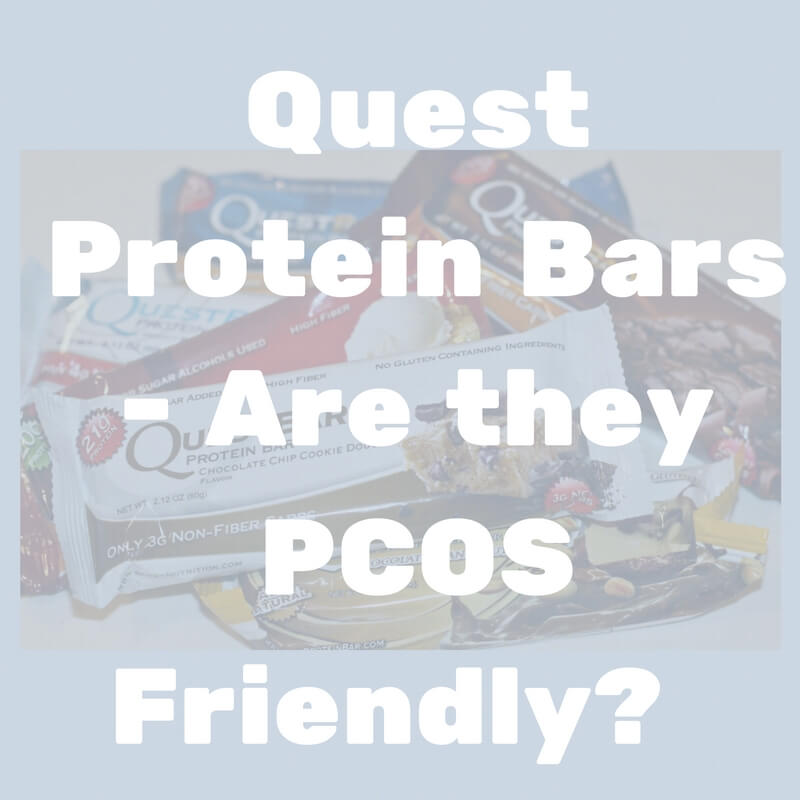
by AmyPlano | Sep 8, 2016 | PCOS Breakfast Foods, PCOS snacks
Choosing a protein bar that is PCOS friendly can be tricky! With such a variety of choices it is no surprise you are overwhelmed. Question – do you even know what you should be looking for when shopping for protein bars? Should you look for bars that are low in fat? Low carb? Low sugar? High fiber? It seems like the list of variables are endless! But don’t worry the PCOS Dietitian has your back 🙂
To help you make the best decision for your PCOS, I have decided to write a an educational series of blogs on several of the popular protein bars on the market. It is my goal to discuss the different bars and explain whether I would give them the PCOS stamp of approval. Please be mindful there are SO many reasons why someone might choose a particular protein bar. However, I am going to do my best to break down the protein bars down into four specific criteria: nutritional profile, ingredients, cost and taste. Each week I will review a different bar and base my review on the same criteria. That way you can make your own comparisons and select the best protein bar based on the information presented. So now let’s go assess our first bar: Quest Bars.
Quest Protein Bars
Are they PCOS Friendly ???
I decided to start by reviewing one of the most popular protein bars on the market: Quest Bars. For about the last three years, Quest Bars have claimed their fair share of the protein bar market. Touted nutritionally for their high protein, moderate carbohydrate, high fiber make-up Quest Bars are without a doubt a popular choice among protein bars. But how do they stack up for our specialized population of PCOS cysters? Let’s see …
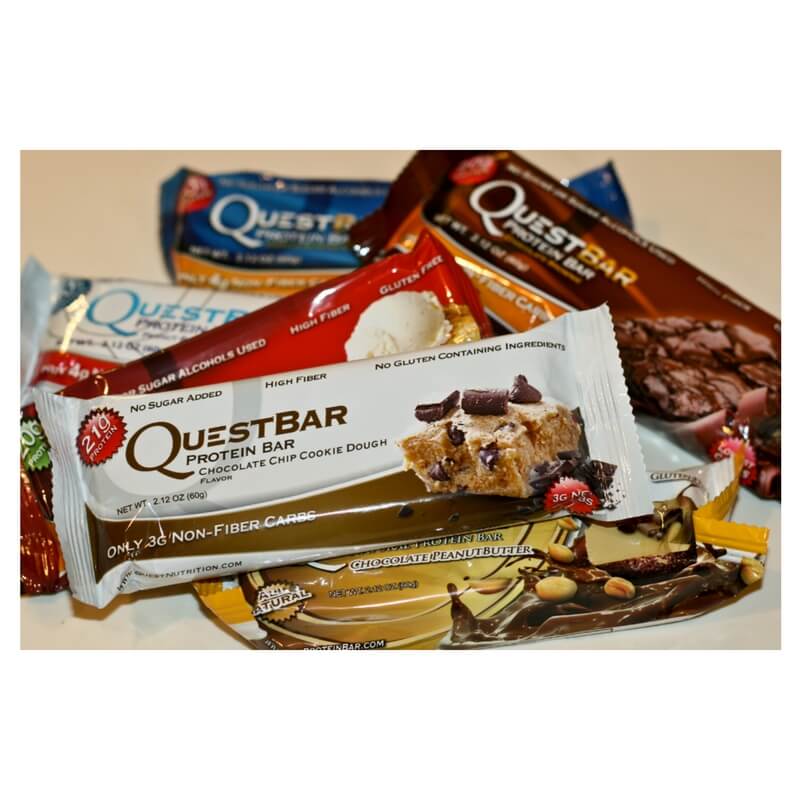
Quest Bars are an example of one of the many PCOS friendly protein bars
Nutrition Profile
From a nutritional stand point Quest Bars present the PCOSer with a solid profile. Quest Bars are all about 190 – 200 calories per bar. Therefore, depending upon where someones calorie level is set, I would either recommend a Quest Bar as a meal replacement (in a pinch) or one of their snacks. For women with PCOS who only command a small number of calories, I might suggest splitting the bar into two pieces and consuming as two separate snacks.
Protein
One of the things I like best about Quest Bars is they are a true protein bar. What I mean by this is they actually have a significant amount of protein in each bar. I know this sounds like a no-brainer when we are talking about protein bars – but you would be surprised how many bars you think are protein bars actually have very little protein in them. In order for me to call a bar a protein bar, it must have at least 15 grams of protein in the entire bar. Anything less than 15 grams is more likely considered a snack bar and not what I would consider a protein bar.
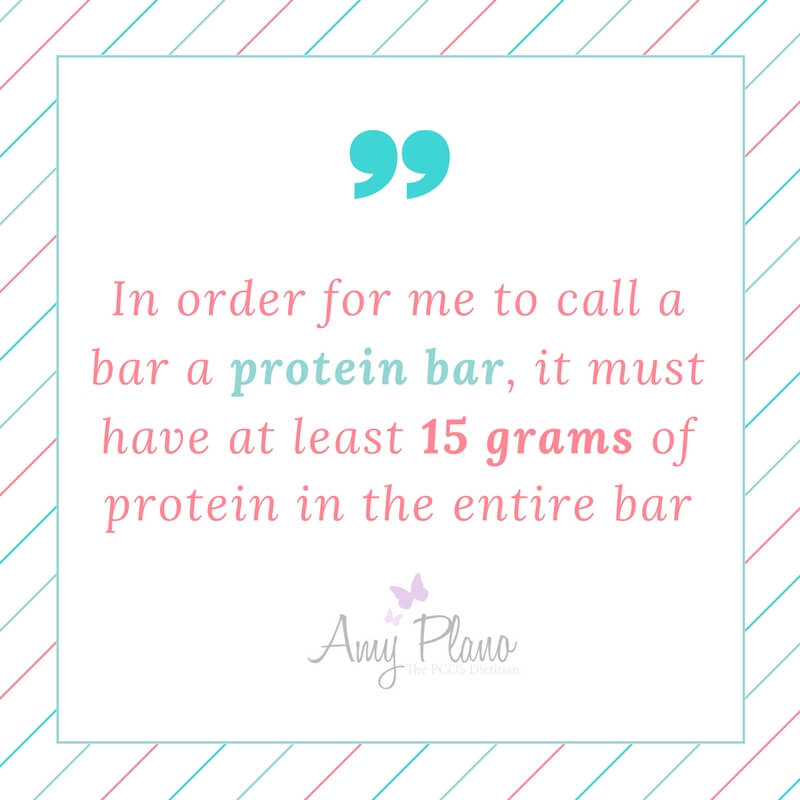
The PCOS dietitian’s rule for determining whether or not a bar is really a protein bar
Of note – we will be examining bars in this weekly series (such as Kind Bars) that do not meet my true protein bar criteria. This does not mean a bar is not a good bar if it does not have 15 grams of protein – it just means we cannot really call it a protein bar. So hang tight and we will get to that in the future! I wanted to start with a true protein bar and that is why I chose Quest Bars.
Quest Bars have a whopping 21 grams of whey protein! For some women that could account for about 1/4 of the protein they need for the day. Protein breaks down slowly and promotes a feeling of fullness. This is why I often recommend Quest Bars for busy women with PCOS who are on the run. Quest Bars make a great high protein breakfast choice! They are a nice alternative to eggs and/or smoothies. Plus they need a lot less time and effort as well. No blender or cooking skills required!
However, be mindful if you are sensitive to dairy or are lactose intolerant you may have a hard time digesting Quest Bars. Due to the fact their main source of protein is whey (which is a derivative of milk!) you may need to consume them with caution if you are sensitive to dairy. Many patients who are lactose intolerant experience cramping, diarrhea and gas when they consume Quest Bars. So just be careful!
Toal Carbohydrates & Fiber Content
You know in the world of PCOS we could never talk about protein bars without talking about their specific carbohydrate content. Not only are Quest Bars high in protein, they are also moderate in carbohydrates. I often consider a food moderate in carbohydrates if has between 15 – 30 grams of carbohydrates per serving. Per bar, Quest has only 21 grams of carbohydrates per serving. On most of my nutrition plans for women with PCOS, I allow for around 100 grams of carbohydrates per day. Therefore, Quest Bars can fit nicely as quick meal or snack option in my eating programs.
Fiber
As you can see in the image of nutrition facts below, Quest Bars contain a high amount fiber. They have 14 grams of fiber per bar which is about 60 % of your daily needs. Fiber is a type of carbohydrate the body cannot breakdown. Therefore, it goes out the same way it comes in! TMI!
Almost all the carbohydrates in Quest Bars come from fiber. Fiber helps you stay full and keeps your insulin levels low. Fiber can also prevent certain diseases, control hunger, and improve digestive health. IMO is the specific type of fiber Quest Bars contain. IMO comes from plant sources. It is similar to chicory root fiber, having the same texture, feel, and taste. It is also helpful for weight loss.
Be Careful if you have any GI Issues
However, with that being said (especially folks with stomach and intestinal issues – such as Crohn’s Disease, Colitis & Irritable Bowel Syndrome) some people have a hard time digesting the large amount of fiber in Quest Bars. So in addition to feeling full, they may also experience significant bloating and gas. If you are one of these people, I would HIGHLY suggest starting off consuming only small portions of the Quest Bar – maybe only a quarter of a bar at a time. While the fiber will do no long term damage, I would hate you to be gassy and bloated – as there is nothing fun about that!

Quest Protein Bar Nutrition Facts
Ingredients
Artificial Sweeteners
Most Quest Bars contain sucralose, an artificial sweetener, erythritol, a sugar alcohol, and stevia, a sweetener and sugar substitute extracted from the leaves of the plant species Stevia rebaudiana Stevia and sucralose appear in the last of the bars’ ingredients. Sucralose is just a different name for the more commonly known sweetener Splenda. This shows it they appears in small quantities. Splenda appears after other low-sugar sweeteners such as stevia and erythritol.
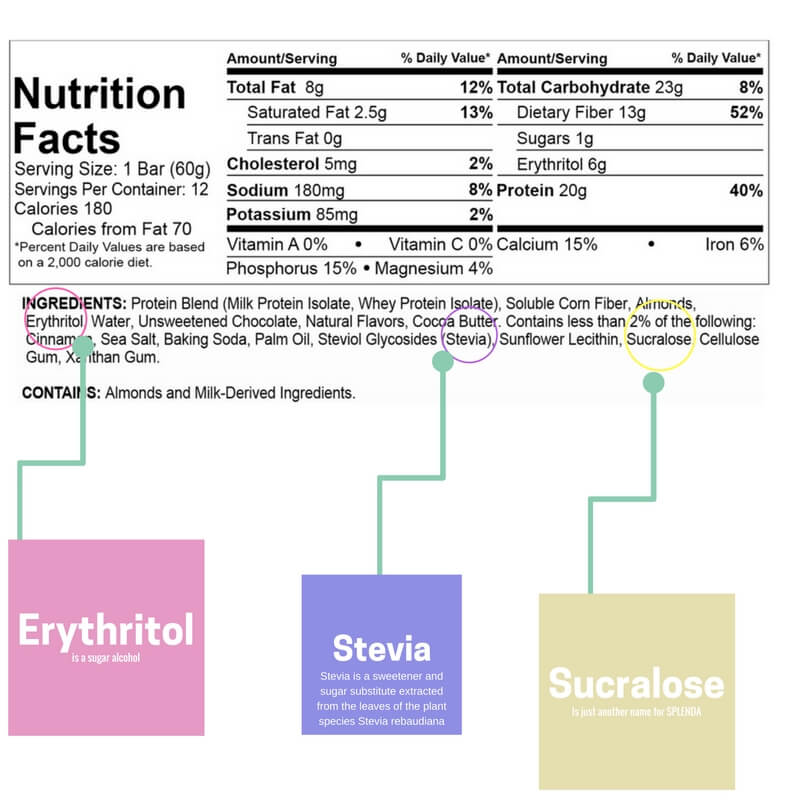
Quest Protein Bars: The Highlighted Ingredients are the Different forms of sweeteners this particular bar contains
However, there are actually 7 Quest bars that don’t contain artificial sweeteners. Are they the most natural food in the world? Not at all, but you have to pick your battles sometimes. If you do choose to eat a Quest bar, you might want to choose carefully based on the type of sweeteners they contain.
Quest Bars without artificial sweeteners:
Cinnamon Roll
Strawberry Cheesecake
Double Chocolate Chunk
Lemon Cream Pie
Chocolate Peanut Butter
Many people ask me my stance on artificial sweeteners. In all honesty, I really have no stance. I truly feel like whether you choose to consume artificial sweeteners is a personal preference. For me personally, the research on the dangers of them is just not convincing enough.
On the flip side, that does not mean I am advocating you consume a boat-load of any type of sweetener! However, like everything I firmly believe if consuming a Quest Protein Bar is the worst of your dietary ills then you my cysta’ are in good shape. In future blogs I will dive into some of the research surrounding artificial sweeteners – but for you now all I can say is eat REAL food when you can.
Gluten Free
Quest Bars are gluten-free. However, with that being said, be careful (as I just noted!) if you do have any GI issues due to the high fiber content of these bars.
Dairy
Quest Protein Bars do contain dairy. But as we will discuss they have a form of dairy that is almost virtually lactose free. Boom!
If you view the label you will see the first ingredient states “Protein Blend: Milk Protein Isolate, Whey Protein Isolate.” The milk protein isolate is a no brainer – obviously it is made from milk and a dairy derivative. What may not be so obvious is the ingredient: ‘whey protein isolate.’
Whey is one of the two major components of milk. It is the liquid part of the milk that separates from the curds (the other major part), during the process of making cheese. However, what we want to zone in on is the type of whey contained in Quest Bars. Quest Bars contain whey isolate. Whey isolates contain a higher percentage of pure protein and can be pure enough to be almost lactose free, carbohydrate free, fat-free, and cholesterol free. So even if you are lactose intolerant, Quest Bars may still be an okay option for you as they tend to contain low amounts of this lactose.
Cost
Quest Bars are pretty comparable to all protein bars on the market. They are available from every where from Trader Joes, to Whole Foods, to Vitamin Shoppe, Amazon (obviously!) and even gas stations such as Mobile and 7-Eleven. They tend to be the least expensive when bought in bulk on Amazon where you can buy a box of 12 for $23.79 which comes down to about $2.00 per bar. I have seen them in 7-Eleven for anywhere between $2.25 to $3.00 per bar. The Trader Joes near me in Orange, CT sells them for around $2.39. If you find a flavor you love — Amazon is always your best option.
Taste
I have tried almost all flavors of the Quest Bars. You can order a variety pack on Amazon if you are interested in sampling different types from fruity ones (think Apple Pie & Lemon) to chocolatey ones (Mint Chocolate Chip, Chocolate Chip). The flavor choices are seemingly endless.
Favorites
However, my personal favs are: Chocolate Chip Cookie Dough and Cookies and Cream. I would have to say I like the Cookies and Cream the best as it reminds slightly of eating Oreo Cookies 🙂 I recently tried the Oatmeal Raisin Chocolate Chip thinking that it would taste like an oatmeal raisin cookie – but I was sadly disappointed. Many people who I work with also love the S’mores flavor but I have to say it just does not do it for me.
Duds
The flavors I like least are the fruity ones such as Apple Pie, Lemon and Mixed Berry. They tend to taste very artificial to me – more so than the chocolate based-bars. I don’t think I could ever finish a whole ‘fruit – based’ bar. It would probably make me sick to my stomach.
Texture
The texture of these bars is dense and chewy. They remind me a bit of the original Power Bars that first came out in the late ’90s. I cannot say I would ever describe them as ‘light’ such as I might a Power Crunch bar. There is very little ‘crunch’ appeal to them at all. I think this is due to the high fiber content. It is tough to make something appear light when you have put 50 % of someone’s daily fiber requirement into one little dinky little protein bar.
After Taste?
Most of the Quest Bars have a somewhat distinct after-taste. Even the ones sweetened with Stevia. It is not horrific by any means. But I would be lying to you if I said they tasted amazing. However, with that being said – they taste better than most of the other bars on the market. But that may not be saying much!
The PCOS Dietitian’s Verdict – Quest Protein Bars
Hmmm … this is a tough one. I think Quest Bars are like many foods; they look good on paper, but can they stand up tall among all the categories ?
In terms of a nutritional profile, I would give Quest Bars an A/A-. They are solid. They are low enough in carbohydrates (~ 20 grams), high enough protein (20 grams, too!) and wicked high in fiber (13 grams) to fit into the class of being PCOS friendly for sure.
The ingredients I would consider somewhat iffy. While there are not a ton of ingredients and fillers like most bars – they still have artificial sweeteners (typically in the form of Splenda) and Palm Oil which is a highly refined saturated fat. For ingredients I would give Quest Bars a C+/B-. I wish they would get rid of the Splenda or at least show more directly that surcralose is really Splenda in disguise.
Cost they get a solid B. They are comparable with all the other protein bars on the market. You have to keep in my mind they have 20 grams of protein in most bars which is the equal to 3 ounce of chicken. So if you look at them that way – they are a good value when it comes to getting your protein in. Especially if you don’t love animal protein.
Taste the get a B They are not the most horrific tasting bar on the market – but they are certainly not something I would choose to eat all day. I think given the fact they have so much fiber and contain artificial sweeteners it would be virtually impossible for them to taste amazing given their nutritional make-up.
So all in all – I would probably rate Quest Bars overall a solid B. Relative to other bars – they will likely score higher – but still not A material.
As with any bars no matter what the brand – I would always encourage real food over supplements when possible. However, I am a realist and understand we all live in a busy, fast-paced world where sometimes food prep is non-existent. Quest Bars can certainly ‘pinch hit’ for a breakfast, lunch or snack. But do your best to round out the rest of your diet with clean sources of protein such as eggs, chicken, greek yogurt, cottage cheese, lean red meat and turkey.
What’s your take on Quest Bars? Love ’em? Hate em’? Have a favorite flavor you are dying to share with our community? Tell us in the comments below.
And as always thanks for stopping by!


















